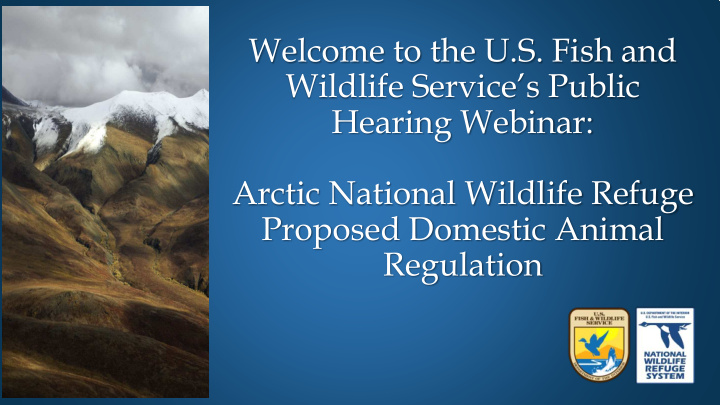



Welcome to the U.S. Fish and Wildlife Service’s Public Hearing Webinar: Arctic National Wildlife Refuge Proposed Domestic Animal Regulation
Overview of this Hearing Background National Wildlife Refuge System Arctic National Wildlife Refuge Draft Regulation Purpose of the draft regulation Arctic Refuge Revised Comprehensive Conservation Plan (CCP) & USFWS National Hunt/Fish package Public Hearing Process Closing Remarks
Department of Interior – U.S. Fish & Wildlife Service • National wildlife refuges (NWRs) are managed by the U.S. Fish and Wildlife Service (Service) for the conservation, management and, where appropriate, restoration of the fish, wildlife and plant resources and their habitats within the United States for the benefit of present and future generations of Americans. • The NWR System includes 568 NWRs, 38 wetland management districts and 5 marine national monuments.
Arctic National Wildlife Refuge Largest Refuge • in the Nation Includes 7 • million acres of wilderness 3 Wild and • Scenic Rivers No road access, • only accessible by foot, boat or aircraft
Arctic National Wildlife Refuge Alaska National Interest Lands Conservation Act (ANILCA): …. to conserve fish and wildlife populations and habitats in their natural diversity including, but not limited to,…….Dall sheep
What is being proposed? 50 CFR § 36.39 (k) Arctic National Wildlife Refuge. All domestic sheep, goats and camelids are prohibited.
Why are we proposing this regulation prohibiting specific domestic animals on Arctic NWR? - To mitigate disease transmission to wild ungulates, particularly Dall’s sheep, consistent with laws, mandates and policies directing management of the Arctic National Wildlife Refuge. - Domestic goats, sheep and camelids have either A) demonstrated the threat of disease transmission to wild sheep or B) Have been documented to harbor diseases that can negatively affect naïve wildlife and environments.
Scientific/Risk Assessment References Garde ,E., Kutz, S., Schwantje, H.,Veitch, A., Jenkins ,E.,and Elkin,B. (2005). • Examining the Risk of Disease Transmission Between Wild Dall’s Sheep and Mountain Goats, and Introduced Domestic Sheep, Goats and Llamas in the Northwest Territories Schwantje, H. and Stephen, C. (2003). Communicable disease risk to wildlife • from Camelids in British Columbia. For British Columbia Ministry of Water, Land and Air Protection Biodiversity Branch, Victoria, BC Center for Coastal Health. (2017). Risk assessment on the use of South • American Camelids for Back Country Trekking in British Columbia.
Arctic NWR 2015 Revised CCP • Chapter 2 2.4.12.9 Disease Prevention and Control …..In particular, domestic sheep, goats, and camelids (e.g., llamas and alpacas) are recognized as being at high risk for carrying disease organisms, often asymptomatically, that are highly contagious and cause severe illness or death in Dall’s sheep (Garde et al. 2005). Therefore, domestic sheep, goats, and camelids are not allowed on Arctic Refuge. This restriction is subject to promulgation of regulations for non-commercial uses.
National Hunt and Fish Rule for NWRS • The proposed prohibition of domestic sheep, goats and camelids on Arctic NWR is part of a broader USFWS national hunt/fish package that was published on April 9, 2020. • The comment period for the proposed rule closes on June 8, 2020. • Additional options to comment
Webinar Public Hearing Process • We will first call on participants who requested to offer a comment when they pre-registered using the registration link. • We will then open the public hearing to anyone who would like to offer a comment. We will first go through those participants who request to comment using the chat function. • We will then move on to those participants calling in through the phone who would like to offer a comment.
Offering a Comment – Pre-registered participants • When it is your turn to comment, the meeting facilitator will call out your name. When you hear your name, please use the “raise hand” feature so that the facilitator knows you are available and ready to offer your comment. • Once you have raised your hand, the facilitator will then unmute you and start the timer. Please spell out your first and last name before providing your comment. We will have your name displayed on the screen. • You will have 3 minutes to offer your comment. You will see a stopwatch on the screen showing you how much time you have remaining to offer your comment.
Commenter Name:
Offering a Comment Using the Zoom Web Platform or Zoom App • To indicate that you would like to offer a comment, please click the “chat” icon at the bottom of your Zoom screen and send a message to XXX, with your full first and last name spelled out. • When the facilitator calls your name, please use the “raise hand” feature hand to indicate that you are ready to offer your comment. The facilitator will then unmute you and start the timer. • Again, please spell out your full first and last name before you provide your comment, and your name will be displayed on the screen.
Commenter Name:
Offering a Comment Using the Phone Only • If you are calling in through your phone and you would like to offer a comment, please press *9 to “raise your hand.” When it is your turn to offer your comment, the facilitator will read the last four digits of your phone number, unmute you, and start the timer for you to offer your comment. • The facilitator will give you a 1-minute warning and a 30 second warning to let you know how long you have left to offer your comment .
Commenter Name:
Thank You • We will now open the hearing to those that would like to comment on the proposal
Closing Remarks • You can access additional documents and more information at https: https://www.fws.gov/refuge/arctic/ • Send written comments to: Attn: FWS-HQ-NWRS-2020-0013 U.S. Fish and Wildlife Service 5275 Leesburg Pike MS: PRB/PERMA (JAO) Falls Church, VA 22041-3803 • Comment online: h ttps://www.federalregister.gov/documents/2020/04/09/2020-06258/2020-2021- station-specific-hunting-and-sport-fishing-regulations
Recommend
More recommend